—-
To stay in the loop with the latest features, news and interviews from the creative community around licensing, sign up to our weekly newsletter here
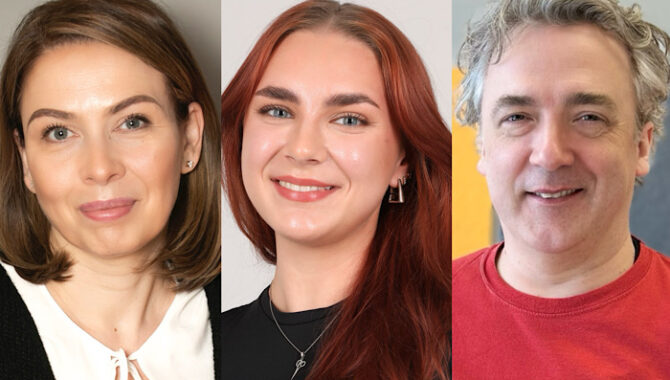
Three of the team from Rainbow Productions talk costume-character design, manufacture and more.
It’s a triple hander! That being the case, I’ll let you introduce yourselves…
Magdalena: I’m Magdalena Foulkes, I’m the Licensing Director. I oversee and develop Rainbow’s relationships with the international licensing community. That includes the development of new costume characters and the acquisition of new licenses. In cooperation with our Digital Division, I coordinate the development of interactive activations to enhance our support of the brands we represent.
Wow, okay… You have a lot of responsibility, Magdalena. Doesn’t sound like there’s much for the other two to do, but let’s find out! Ha! Karolina?
Karolina: Ha! I’m Karolina Borysiuk; I oversee the digital side of the company which is currently growing daily. My digital-in-tray is varied to say the least… One minute, I can be working on character design; the next, floor plans or dressing instructions. In fact, that’s what I enjoy about role: that it’s so varied. Essentially, I have an aesthetic presence and I design and present all the company’s in-house and external visuals.
Perfect. And speaking of aesthetic presence…
Crispin: Thank you, I’ll take that! I’m Crispin Lowrey and, for over 20 years, I’ve been Rainbow’s Head of Production. Fundamentally, I coordinate the workings of the Production Department ensuring we hit deadlines, maintain quality and see that there’s cohesion and collaboration across all divisions and departments. Our clients know their brands well and my role is ensuring the essence of their characters works perfectly in a real-world environment.
Okay! So: Magdalena – overseeing everything licensing; Karolina – making it look good, Crispin – putting it together! So… Thank you all for joining me. For those that haven’t heard of Rainbow Productions, what do you actually do?
Magdalena: Above the door it says we’re a costume character manufacturer and live-event specialist but – as you’ll see today – we’re so much more than that! What Rainbow Productions does is quite unique and amazing – as are the people that work here. Bursting with creativity, Rainbow is this great amalgamation of highly skilled people who are very enthusiastic about what they do. Collaboration, creativity and innovation are at the heart of the organisation.
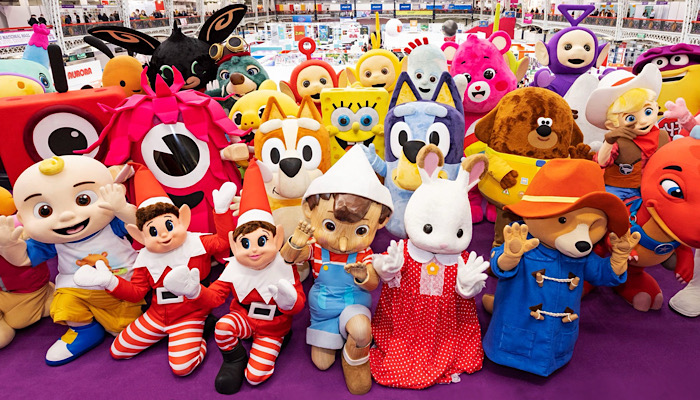
Beyond manufacturing costume characters, you train the people inside them, and repair the costumes after a certain amount of wear and tear?
Magdalena: Exactly. Inevitably, any fabric garment requires some TLC and benefits from a professional spruce up… So we have a whole department able to get a costume back to ‘as pristine’ as possible. As we’re so global nowadays, we’ve created a sub-brand called the Mascot Doctor. Through a series of uploads, we enable our clients to effect some changes themselves without the need to return the costumes to our studios.
Crispin: We also have an absolutely great events department that helps bring the characters to life. They audition, cast and train performers to portray the physical characteristics of a character ensuring that every event is as great as each character looks.
That’s something I’ve found at Toy Fair and BLE… The excitement these characters generate is enormous. I’m a fully grown man, but I’ll always hug a Care Bear or invite a Smurf into a meeting if they’re passing. Ha!
Karolina: Ha! Yes, because the costumes bridge the gap between the design world and the physical world, and the emotional connection they create help make dreams come true.
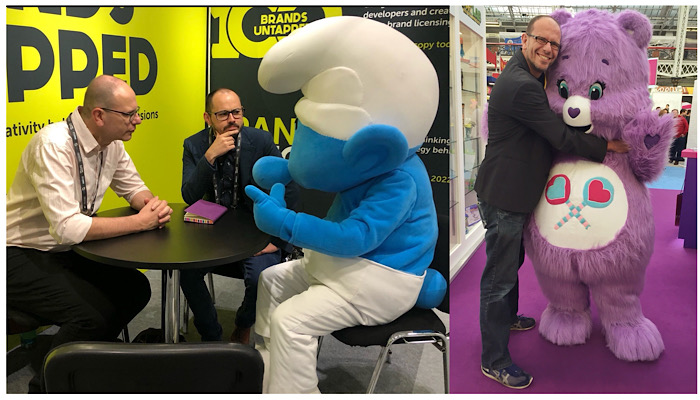
Crispin: Some characters are irresistible. And often, they’ve come to life for the first time through Rainbow Productions – even for the licensors… It’s the first time they see these characters as real and tangible in the same space as them.
And for reference, what are some of the licences that Rainbow Productions has?
Magdalena: We’re really privileged to work with over 140 licences here… We have a lot of A-listers; all the huge brands you see on TV, at the cinema and in shops. We also have some smaller nostalgia brands that still have very loyal fan groups. And, of course, we work with brands who are just at the start of the journey; those in development or very new… As a result, we’re well aware that we need to treat every brand individually. And we’re continually acquiring new licences because the market is changing all the time.
So if I’ve got a company logo – a two-dimensional mascot, say – and I now want to see my mascot walking around, what’s the process?
Magdalena: Often, this is the most exciting moment for us: when someone comes to me or to the sales team with the idea for a character. We love to explore this; to discuss all the options, all your views, and see your excitement about the character. And then we would, with all these great ideas after the brainstorm, go to Crispin…
Crispin: And this is the best part of my job. Fortunately, I have an incredible production management team; each one specialising in different components of a costume character and collaboratively we will always work out a way to make any project happen. You want it round but square, able to skydive, ski down a mountain – we’ll somehow find a way.
Ha! So you’re really pushing to find ways to make things work?
Magdalena: Yes, exactly. Even if something looks impossible, the team here is so great that – more often than not – we talk in terms of how we can do something… Even though it looks impossible.
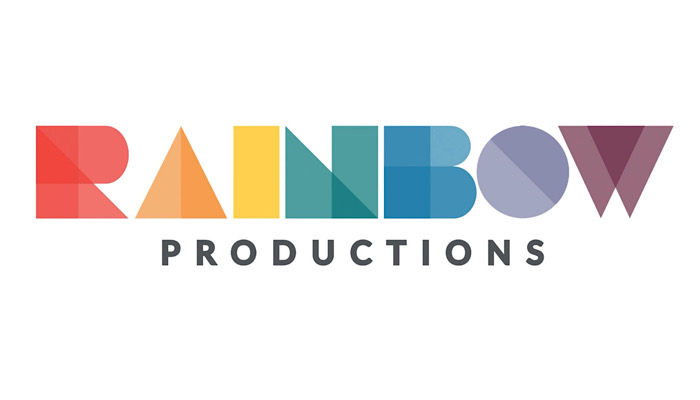
Crispin: Yes. We’re always asking: How can we do this? How can we make this three dimensional? How can we fit a person inside that shape? Because the challenge is often the real worldliness of it… Often, when people draw a cartoon character, for example, no one’s ever thought about how that character would actually fit through a standard-sized door.
Right! So with Peppa Pig – by way of example – she’s been conceived in two dimensions. So there must be enormous challenges to bring her to life?
Crispin: Yes, and Peppa Pig is a good example, actually. Beautiful and brilliant as the illustrations are, there was no reason – initially – for anyone to think about her in the real world. So on paper, Peppa always has two eyes on one side of her head. But what does she have on the other side of her head when she’s a three-dimensional character? That’s the sort of challenge you face in bringing a character to life.
And how do you start solving them?
Crispin: That often starts with Karolina taking a two-dimensional drawing – even if that two-dimensional drawing is drawn in three dimensions, if that makes sense – so that it has depth. And then thinking: does this character have a tail? How big are their feet? How wide is their body? How might they go up and down a set of steps? The very practical logistics of things like that can quite drastically affect the proportion of the character.
So this is where the skill set of Karolina and the team working here is vital. Because even humanoid characters with two arms and two legs aren’t necessarily proportioned like humans. Design wise, that is literally the starting point for everything we do.
It’s got to be a human in it?
Crispin: Most of the time, yes although we also specialise in creating puppets and dressing costume characters onto mannequins. All costumes are tailored for specific heights of performers and, sadly, one size very rarely fits all. In fact, as with any bespoke tailoring: ‘one size fits no one’ if that makes sense?
It does, yes. Someone’s got to be inside there – and afforded some degree of safety and comfort!
Crispin: Yes, that’s another thing! You’ve got to ensure someone can move and see! That’s incredibly important. Even when we get as far as some of the sculptural phases – and we have incredibly talented sculptors here – you see this beautiful sculpture and have to solve the problem of vision.
That’s why the apertures in some of these characters are tiny! This is why the costume chaperones; the helpers that guide the characters around – are such a huge asset. They’re so good at what they do; they also get trained by our events department.
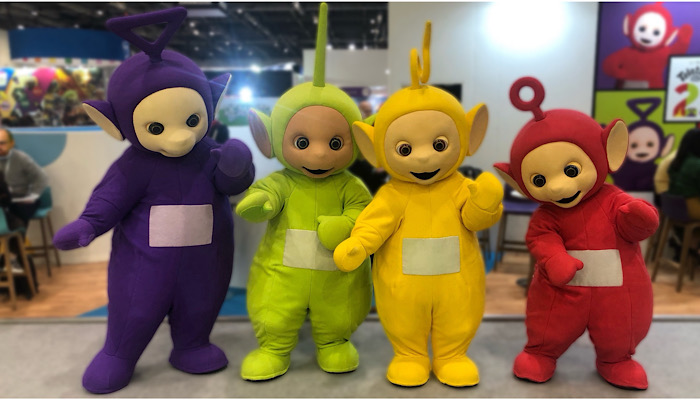
In terms of the design process, then, would I be right in saying that you have to establish the character’s personality before you start designing, Karolina?
Karolina: Yes, it always begins with a brainstorm of which characteristics they need to have. Occasionally, we’ve started work on a costume from scratch… I’ve not even been given any visuals! There have just been scripts or songs, for example, and an idea that the character is going to be a fish. There, we’d have to imagine the songs being sung and think: ‘What’s this fish going to be about? What’s she going to look like? Happy? Mischievous? Sporty? Regal? Grumpy?’
I like that you’re pulling those faces as you walk me through the emotions! And is there more than one type of the same character, Karolina? To reflect a different mood, say?
Karolina: Not necessarily more than one type to reflect a different mood, no… But there can be more than one version of the same character, depending on where that character is portrayed.
Crispin: For example, there are often different iterations or versions of the same character. A character which appears in books can be radically different
to a character which appears on TV or in Movies.
Ah! Yes, I hadn’t thought of that!
Magdalena: Also, characters change over the years as brands evolve and refresh. Consequently, we have to keep the most up to date versions of the characters in our portfolio.
Crispin: And without wishing to spoil the illusion, Deej, we also may have multiple versions of the same character as they may be appearing in different parts of the world on the same day. And each costume character has to be not only identical but also as pristine as the next one. Our performers are trained in each costume, and they also have to understand the unique properties of each costume to enable them to also have total uniformity of character portrayal.
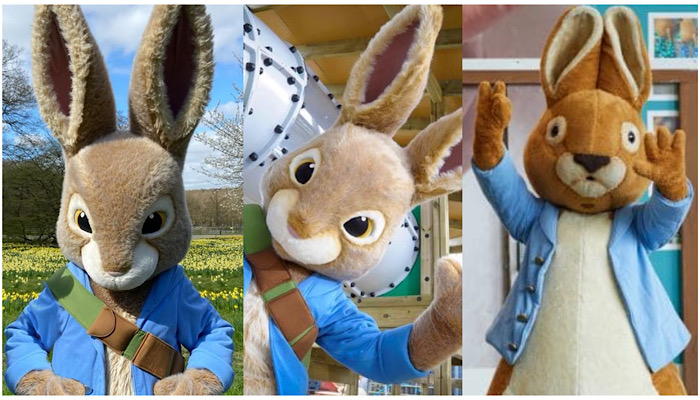
Fascinating. And speaking of the performers, how are they trained?
Magdalena: They’re trained by our events team, led by Victoria Thompson. They make sure that every single artist gets their induction and is trained to portray a particular character…
Karolina: So if you’re Papa Smurf, you’re trained as Papa Smurf you learn Papa Smurf’s moves, then go and quite literally embody Papa Smurf for the duration of the appearance.
I imagine it’s hard work! Crispin, how did you come to doing this?
Crispin: I trained in theatre design, specialising in props and puppet making and performed as a puppeteer. For about four years, I toured as Sooty. Afterwards, I developed a family company, creating puppets, writing shows and making props. Then I started doing puppet shows and was commissioned by Rainbow to work on a particular project at a theme park.
Good LORD! I’m talking to a man that played Sooty!
Crispin: Ha! Then, when I first joined Rainbow, we intended to develop our puppet and animatronic side of the business. I’ve now been here 22 years and the complexity of the designs has certainly changed – but the essence of characters and puppets has remained steadfast…
One of the best things that’s happened to me in my career at Rainbow is that, as the company’s grown, so too have I grown with it. My designs have been realised, my ideas have been developed and my skillsets have been challenged and expanded. That’s one of the best things about being here: if you’re willing to grow, the company will grow with you.
And vice versa, presumably? As technology and materials change?
Crispin: Absolutely, we don’t make things the same way we made them 20 years ago! Or ten or even five years ago in some cases… The speed with which that whole industry has changed is remarkable: Vac Forming, 3D printing, rotocasting and heat pressing are now everyday techniques. Personally, I’m learning everyday too. Rainbow invests in technology and what’s available these days was barely a thought of back when I started. So I’ve gone from being a team of one to growing and going through the ranks, then managing the whole team… Passing on my experience and also being aware that we only grow as long as we keep pushing boundaries and adding new people.
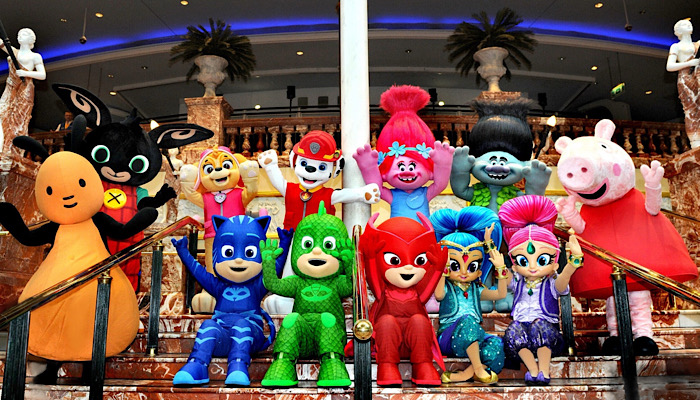
For example, Karolina joined my team having started out as part of our refurb team: washing, repairing and maintaining costumes. She learned how costumes go together and gained experience putting someone in and out of costumes. She already had great skills in illustration, so bonding her practical skill set to the illustration means she can now design a costume knowing it has to be modular, it has to be washable, it has to be practical.
And what’s your background, Karolina? Were you once Kevin the Gerbil? I almost daren’t ask…
Karolina: I studied costume design in Wimbledon, graduating two years ago and this is my first job. I’ve stayed in the same area for the past five years! I did work experience in some London Fashion Weeks and theatres and so on, so I have a whole background of fashion and theatre costumes of different kinds.
And Magdalena, how did you come to be here?
Magdalena: I came across Rainbow Productions 15 years ago when I bought a Peppa Pig costume for my own events company, which was based in Poland. That was first time I’d heard about Rainbow Productions. It was amazing to see everything here and how the costumes were being made and looked after.
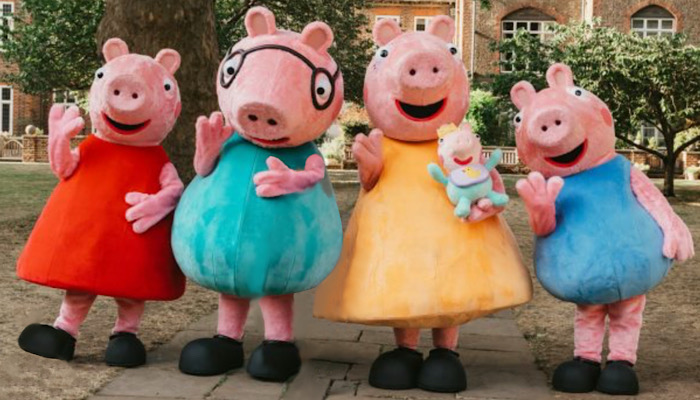
Brilliant! And then what made you stop what you were doing in Poland and come to work here?
Magdalena: That was at the persuasion of my husband, Simon – he’s the Managing Director here!
Ah! Perfect! Well, look… This has been fascinating for me – thanks for having me here! This’ll be the last question – but I’m very curious to hear your thoughts! Is there one character at which you look and think, ‘I’d love to do that costume!’
Karolina: I always go for nostalgia; anything I watched as a kid… So I was going to say Totally Spies – but we made those costumes at the beginning of this year; I just missed it! If you want another, there’s a character you probably won’t know it because I didn’t grow up in the UK. I moved here from Poland when I was five years old…
Oh, I’m even more interested… Of whom are you thinking?
Karolina: So there’s a character called Miś Uszatek. He’s just like a little teddy bear. I used to watch him when I was little, and at the end of every story I would cry. It would make me feel so emotional because I wanted to just give him a hug and I wanted him to be here with me – and I could never have it. I could have a plush toy, but that wasn’t the same. So yes – Miś Uszatek. I always go for the nostalgia.
I love that answer; it clearly means a lot to you. Thank you. Magdalena, same question…
Magdalena: Oh, yes – I think everyone should have a chance to give their favourite character a hug in real life. I think when everyone can do this, our job is done! But for me, there was this dog-like dragon in The Neverending Story… I think this would be a proper challenge, and it would be so great to give it a hug!
What a great answer! Oh, you’ve both set the bar so high… Crispin?
Crispin: It’s a weird one actually… The brand’s gone away a bit now, but it’s great; very joyful… It’s any of the characters from Steven Universe. I’d love to do those because of all the bright colours and bold images – very much my sort of take on things. Then there’s another one that we have made – but it was completed here when I first interviewed 22 years ago, and we’ve never made it again since…
Gosh, this is very suspenseful, isn’t it?! I’m glad I asked!
Crispin: I would love – with all the technology and all of the advances we’ve made – I would love to have another shot at a Blue Meanie from The Beatles: Yellow Submarine. I’d actually be happy with any of the characters from Yellow Submarine, including all four Beatles – but a Blue Meanie would be amazing.
Oh my days! What great answers! Thank you all so much for making time. Fun interview – and I can’t wait to see all the characters on parade at BLE in a couple of weeks. Good luck!

Enter your details to receive Brands Untapped updates & news.